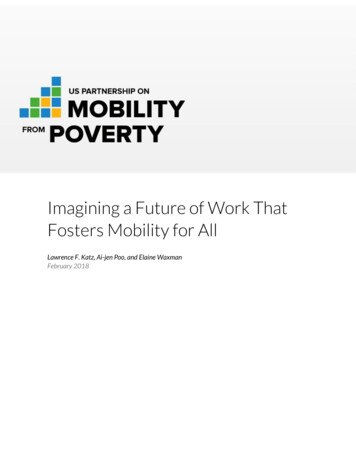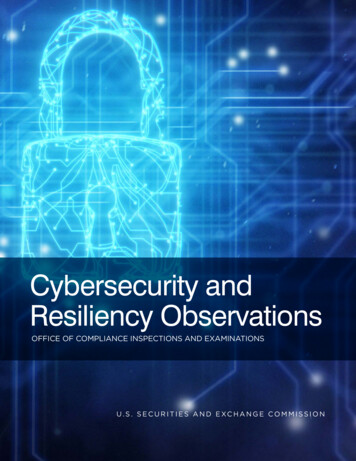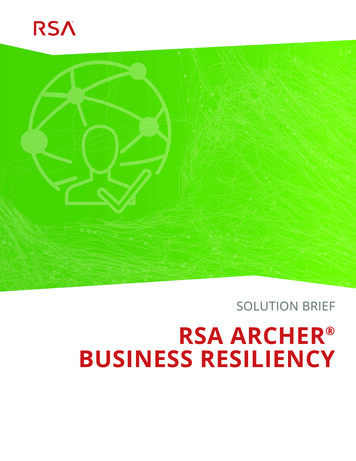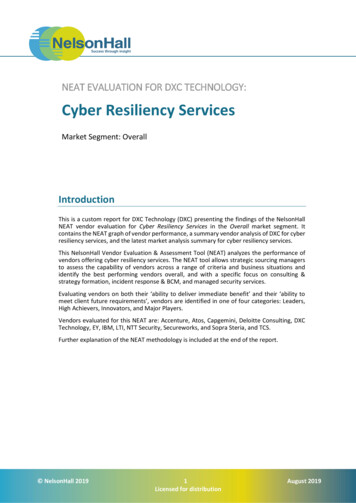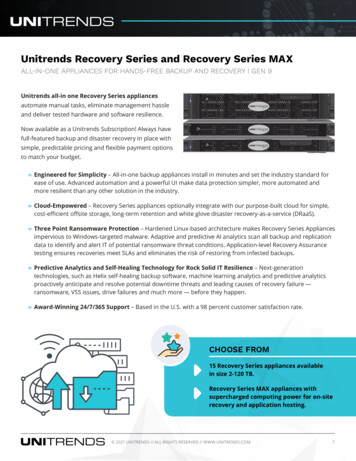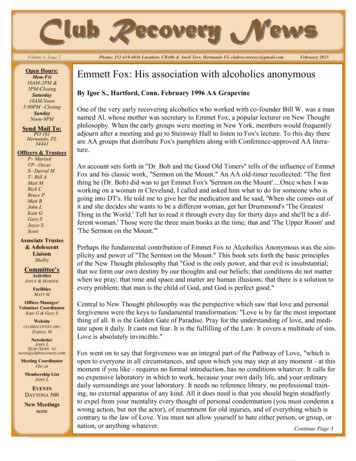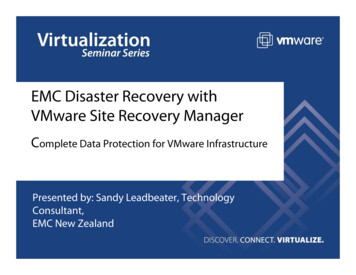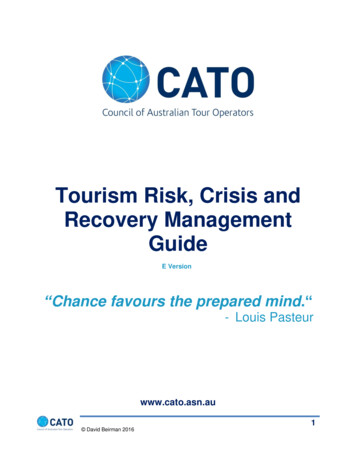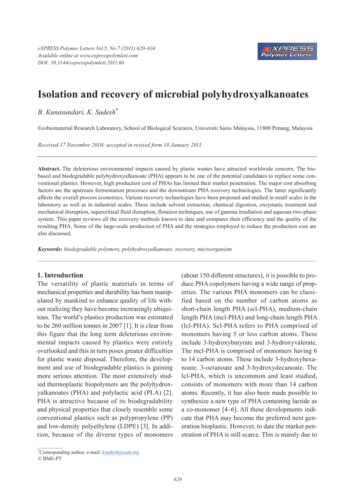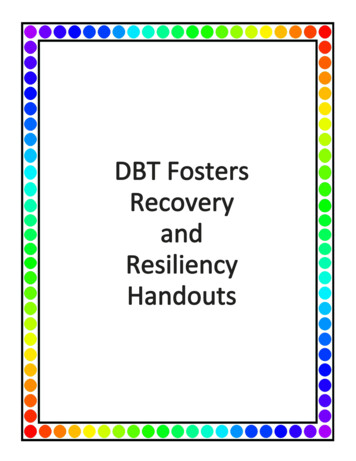
Transcription
DBT FostersRecoveryandResiliencyHandouts
Barriers & ObstaclesBarriers and obstacles are things that get in the way of using DBTskills in our lives. Doing something new, like the skills, usuallydoesn’t work perfectly the first few times. There will be situationswhen we can’t use the skills or don’t remember to do so. To get themost out of the skills it will take lots of practice, particularly at timesbefore we really need the skills. To be the most effective it will beuseful to anticipate potential barriers and obstacles and how we willdeal with them so that we can use the skills effectively.Some of potential barriers and obstacles are:I can deal with these barriers and obstacles by:Skills I can use even when I can’t resolve the barriers and obstacles:14
Building a Life Worth LivingDBT is about building a life worth living. A life worth living isabout having the best life we can have. It is about having a fulllife that sustains us psychologically, emotionally, and interpersonally.My Life Worth Living would look like:Things in my life that get in the way of building a Life Worth Living:Ways I can minimize or eliminate these things:Things in my life that support a Life Worth Living:Ways I can do more things to build a Life Worth Living:12
Some Days Nothing Goes WellDBT teaches us many skills and encourages balance.It provides us with the tools to be in the here and now, to regulateemotions, tolerate distress, and have effective relationships.Even with all of these tools and skills,there are days nothing goes well.Some days and in some situations, we can use all of the tools wehave acquired from DBT and find we still can’t be effective. Nomatter how hard we work or how committed we are to DBT, othersand the environment will be too powerful. Life is still unfair everynow and then.At these times, we may be tempted to give up or throw away ourprogress. We may have an impulse to revert to old, problematicbehavior, have impulses to harmourselves, or a desire to damageour relationships.It is essential when having theseexperiences that we use damagecontrol, patience, and hold a long-term perspective.4
Some Days Nothing Goes WellWays I can identify when the interaction or situation is out of mycontrol:Strategies I can use for damage control:Ways I can be patient:Strategies I can use to maintain a long-term perspective:How do I stay the course with DBT even if I feel it isn’t working:5
Wellness PlanPerson:Date:Describe yourself when you are feeling well:Your Feelings:Your Thinking:List daily activities you need to do to keep yourselfwellYour BehaviorsPhysicallyList activities you may need to do to keep yourselfwellExternal TriggersDescribe past circumstances/events that have leadto a loss of wellness (increase in symptoms)List past solutions that improved wellness(decrease in symptoms)Describe possible circumstances/events that couldlead to a loss of wellness (increase in symptoms)List possible solutions that would improve wellness(decrease in symptoms)
Early Warning SignsDescribe past early warning signs that indicate a loss of wellness may be on the horizonYour Feelings:Your Thinking:Your BehaviorsPhysicallyList past solutions/actions that have prevented aloss of wellnessList possible solutions/actions that would prevent aloss of wellnessThings Are Getting WorseList indicators of increasing loss of wellnessYour Feelings:Your Thinking:List past solutions/actions that have prevented acontinuing loss of wellnessYour BehaviorsPhysicallyList possible solutions/actions that would prevent acontinuing loss of wellness
Crisis PlanningList indicators that others should care for youYour Feelings:Your Thinking:Your BehaviorsPhysicallyWho should care for you?Current MedicationsMedications to AvoidHelpful MedicationsDescribe a workable homecare planList acceptable treatment facilitiesList unacceptable treatment facilitiesList helpful actions others can takeDescribe what others should do if you become a harm to self or othersList helpful actions others can takeDescribe the conditions under which the crisis plan should be discontinuedClient signature:Staff signature:(Adapted from Mary Ellen Copeland’s “Wellness and Recovery Action Plan”)
Preventing RelapsesProblems and difficulties can come back sometimes, so it is useful to figure out whatour warning signs might be and how we can proactively deal with them before they become full-blown problems.Warning Sign:DBT Skill:Desired Outcome:Warning Sign:DBT Skill:Desired Outcome:Warning Sign:DBT Skill:Desired Outcome:If a warning sign continues or worsens, contact your support system or a helping professional.34
Recovery & ResiliencyRecovery is about living optimally and reaching your potential.Being in recovery can be about being substance-free if we havean addiction; however, recovery is more than just abstinence.Recovery is about living beyond our problems. It is a strengthsbased perspective that empowers us to build the life we strivefor. It is about being resilient and bouncing back fromdifficulties and problems. Recovery is something that ispracticed every day. It is imperfect and forgiving.Examples of recovery and resiliency in my life already:Barriers and obstacles to recovery and resiliency in my life:Strategies I can use to overcome these barriers and obstacles:Ways I can increase recovery and resiliency in my life:13
Recovery PlanRecovery is about being the best possible person. It is about reaching our potential while dealing with difficulties, stress, and problems. Recovery is about effectively dealing with mental health andsubstance use problems. It also entails effectively dealing with family and other support systems, work, meaningful activities, recreational opportunities and having fun, etc. The next few pages provide an opportunity to develop a recovery plan which can then beimplemented.This is my plan for recovery and optimal functioning:My life in recovery looks like:Which DBT Skills are most helpful for me?Page 1 of 635
Recovery Plan1. Practicing MEDDSS daily establishes a healthy self-care regimen.Describe how you will approach each piece of the acronym.a. Exerciseb. Diet: Balanced and nutritiousc. Drugs: Prescribed medication as directed and no illicit drugsd. Sleeping: a healthy amountPage 2 of 636
Recovery Plan2. Prevention of relapse or return to problematic behavior.a. The most important warning signs of problems reoccurring:b. When I notice the warning signs, I will use the following DBTskills:3. Healthy Support System:These are the people in my support system who support my recovery and use of DBT skills:Page 3 of 637
Recovery Plan4. Having fun and recreation is an important part of recovery.a. I will ensure I have time for fun and recreation in my life on a regular basis by using the following strategies:b. These are the fun and recreational activities I will participate inon a regular basis to support my recovery:c. I will utilize community support meetings by:Page 4 of 638
Recovery Plan5. Dealing with Stress.a. The most stressful things in my life are:b. Previous ways I have effectively dealt with stress include:c. I will use the following DBT skills to manage my stress:Page 5 of 639
Recovery Plan6. Recovery Goals.a. Progress I have already made toward my recovery includes:b. I am currently working on the following in my recovery:c. I will do the following to maintain positive changes and continuemy growth:7. Other things to consider.Page 6 of 640
DBT and the 12-StepsStep / PrincipleStep OneWe admitted that we were powerlessover our addiction, that our lives hadbecome unmanageable.*Admitted that when we participate indrinking, drugging and acting outbehavior that our lives get out of control.Step TwoCame to believe that a power greaterthan ourselves could restore us tosanity.*Came to believe that we could changewith the help of others.Step ThreeMade a decision to turn our will and ourlives over to the care of God as weunderstood Him.*Made a decision to work with others tomake changes in our behavior and ourvalue system.Step FourMade a searching and fearless moralinventory of ourselves.*Made a list of behaviors we need tochange and recognized the positivestrengths that will help us make thesechanges.Helpful Skills to Use Be MindfulWise MindNonjudgmentalEffectivelyFASTRadical AcceptanceValues and Priorities (Building a Life Worth Living)(DBT-SUD)Be MindfulWise MindNonjudgmentalEffectivelyTurtlingValues and Priorities (Building a Life Worth Living)(DBT-SUD)Be MindfulWise rning Bridges (DBT-SUD)Let Go of Emotional SufferingAvoiding and Eliminating the Cues to Use (DBT-SUD)Values and Priorities (Building a Life Worth Living)(DBT-SUD)Be MindfulWise MindNonjudgmentalEffectivelyRadical AcceptanceFASTTurtlingMEDDSSIdentifying and Labeling EmotionsUrge Surfing (DBT-SUD)Values and Priorities (Building a Life Worth Living)(DBT-SUD)
DBT and the 12-StepsStep / PrincipleStep FiveAdmitted to God, to ourselves, and toanother human being the exact natureof our wrongs.*Shared our list with another person.Step SixWe were entirely ready to have Godremove all these defects of character.*Were ready to leave these oldbehaviors, attitudes and values behind.Step SevenHumbly asked Him to remove ourshortcomings.*Became willing to work with others tochange these old behaviors, attitudesand values.Step EightMade a list of all the persons we hadharmed, and became willing to makeamends to them all.*Made a list of people, includingourselves, who have been hurt by ourbehavior and decided to make amendsto them.Helpful Skills to Use Be MindfulWise MindNonjudgmentalEffectivelyRadical AcceptanceTurtlingDEAR SELFGIVE & FASTWise MindTurtlingLemonadeBurning Bridges (DBT-SUD)Avoiding and Eliminating the Cues to Use (DBT-SUD) Wise MindDEAR SELFGIVE & FASTEffectivelyRadical AcceptanceHalf SmileLemonadeBe MindfulMEDDSSWise MindNonjudgmentalEffectivelyTurtlingFASTBuilding a Life Worth Living (DBT-SUD)
DBT and the 12-StepsHelpful Skills to UseStep / PrincipleStep NineMade direct amends to such peoplewherever possible, except when to doso would injure them or others. *Took responsibility for our behaviorand for forgiving ourselves by makingamends to people who have been hurtby our behavior.Step TenContinued to take a personal inventoryand when we were wrong promptlyadmitted it. Wise MindDEAR SELFGIVE & FASTAttend to Relationships (Building a Life WorthLiving) (DBT-SUD)Alternate Rebellion (DBT-SUD)Half SmileOpposite to Emotion Be MindfulWise MindNonjudgmentalEffectivelyLemonadeTurtlingUrge Surfing (DBT-SUD)Opposite to Emotion (for changing Shame)Alternate Rebellion (DBT-SUD)Adaptive Denial (DBT-SUD)Be MindfulWise MindNonjudgmentalEffectivelySelf-Soothe KitTurtlingGIVE & FASTBuilding a Life Worth Living (DBT-SUD) Be MindfulWise MindNonjudgmentalEffectivelyDEAR SELFGIVE & FASTBuilding a Life Worth Living (DBT-SUD)*Continue to take responsibility forourselves and admit when we arewrong.Step ElevenSought through prayer and meditationto improve our conscious contact withGod, as we understood Him, prayingonly for the knowledge of His will for usand the power to carry that out.*Tried, with the help of others, to be abetter person—someone we can beproud of and live with.Step TwelveHaving had a spiritual awakening as theresult of these steps, we tried to carrythis message to addicts who still suffer,and to practice these principles in all ouraffairs.*Having been able to change our liveswith the help of others, we offer our helpto others.
DBT and the 12-StepsStep / PrincipleThe Serenity PrayerGod, grant me the serenity to radically accept thethings I cannot change, the courage to change thethings I can, and the wisdom to know thedifference.“One Day At A Time”Not using just for today. Focusing on today’sresponsibilities.H.A.L.T.Don’t let yourself get too Hungry, Angry, Lonely orTired. Helpful Skills to UseRadical AcceptanceWise MindTurtlingGIVE & FASTUrge Surfing (DBT-SUD)Wise MindEffectivelyRadical AcceptanceLemonadeTurtlingSelf-Soothe KitOpposite to EmotionAlternate Rebellion (DBT-SUD)Adaptive Denial (DBT-SUD)Urge Surfing (DBT-SUD)Wise MindMEDDSSOpposite to EmotionBuilding a Life Worth Living (DBT-SUD)
an addiction; however, recovery is more than just abstinence. Recovery is about living beyond our problems. It is a strengths-based perspective that empowers us to build the life we strive for. It is about being resilient and bouncing back from difficulties and problems. Recovery is something that is practiced every day. It is imperfect and .

